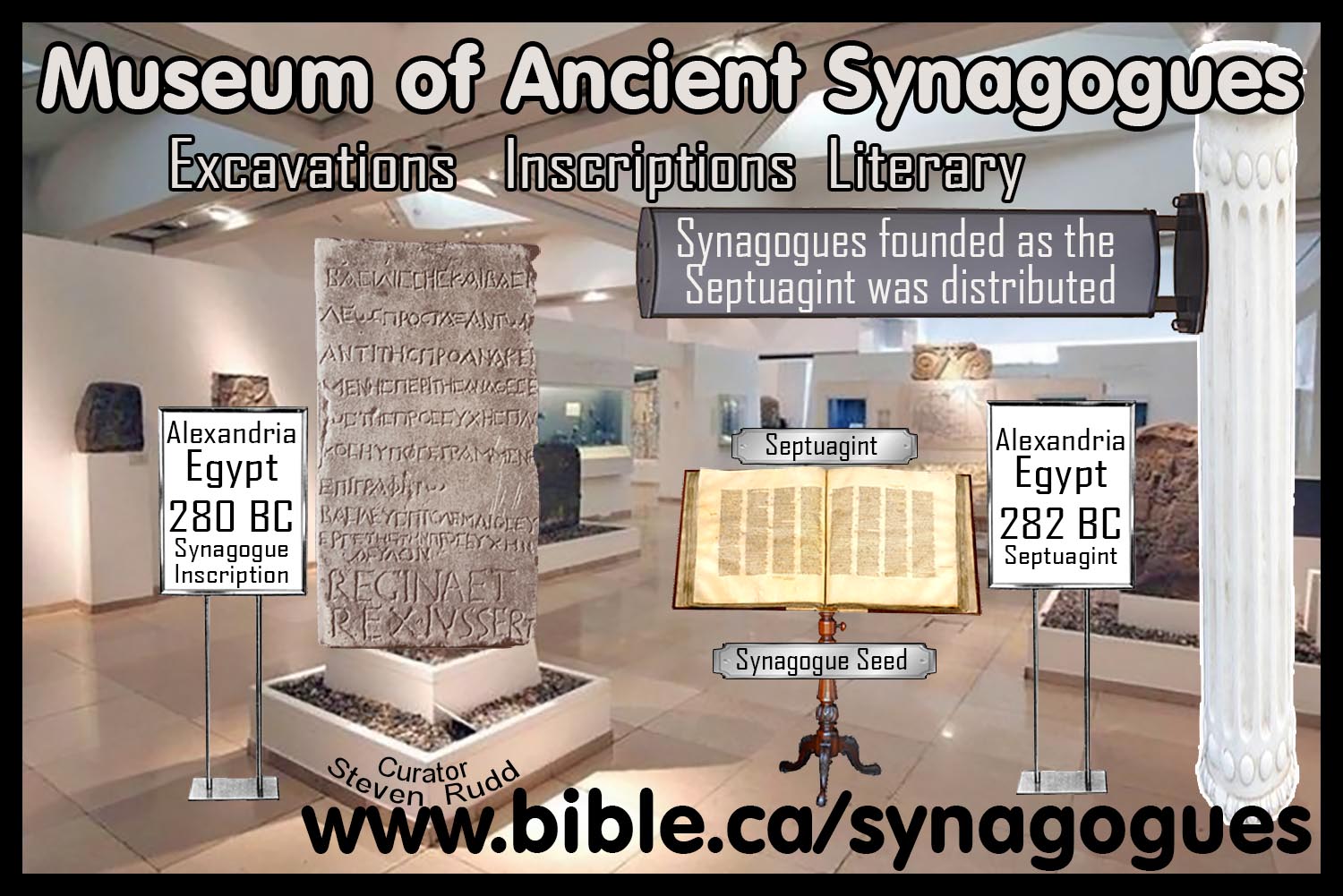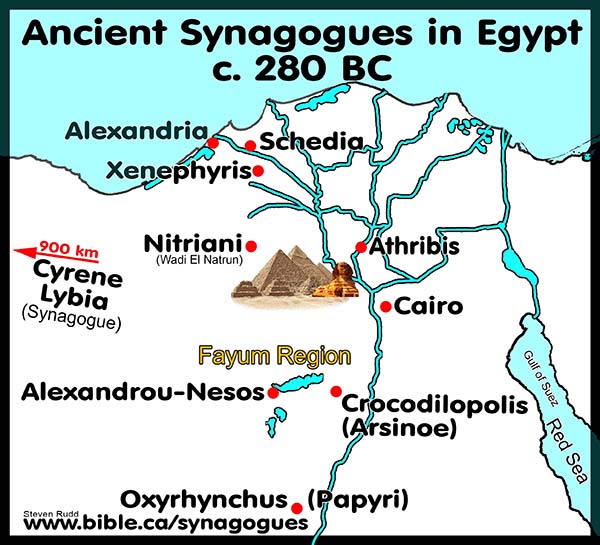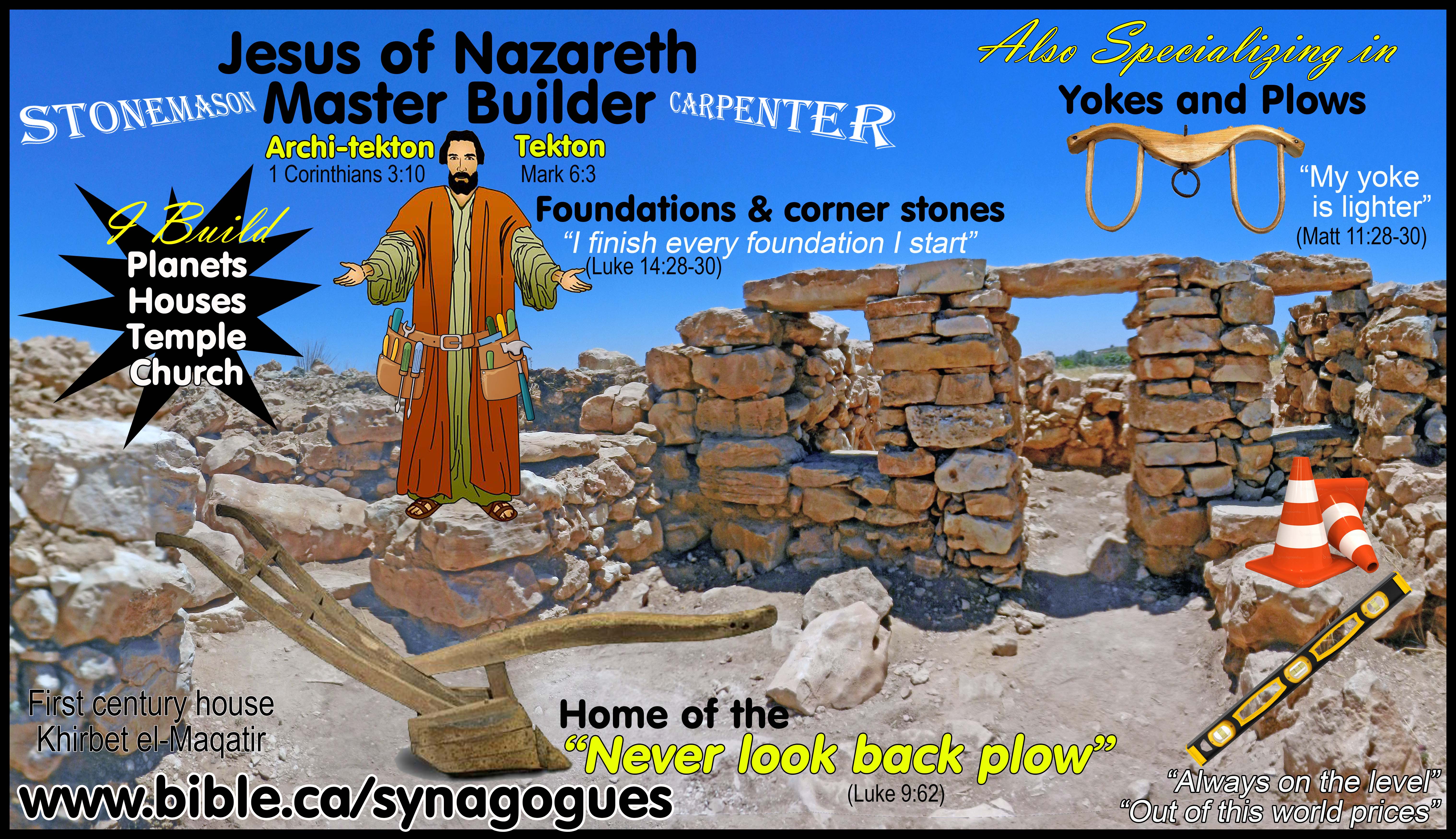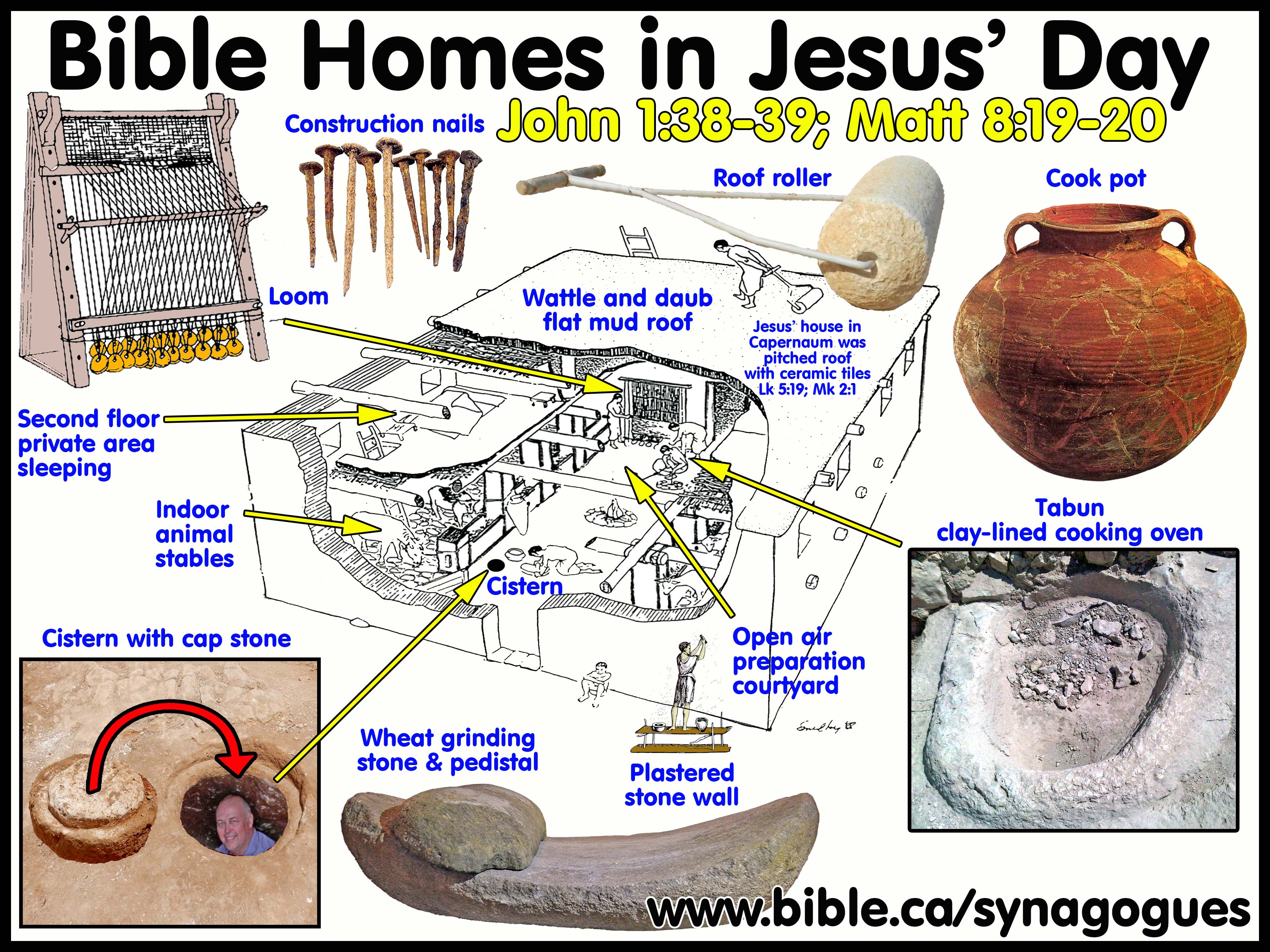|
Role of Women preachers, segregation and Children in Synagogues First Century Synagogues and churches |
“On this Rock, I will build My church”
Ancient Synagogue Worship and the Church
Synagogue worship was the prototype for Christian Church.
|
ROLE OF WOMEN AND CHILDREN IN SYNAGOGUES |
A. Women not segregated from men in the Synagogue worship:
1. Contrary to popular myth, women were not segregated in first century worship services of either the church or synagogues.
a. If you worshipped in a synagogue, you would find entire families worshipping together.
b. The only specialized seating was by trade: Stone masons would sit together. Carpenters would sit together, but otherwise there was no segregation of any kind.
c. The older sat on the higher benches and the younger on the lower benches, but there was no class or sex segregation.
d. Synagogues worshipped exactly like ancient churches and modern churches in united family groups of mother, father and children.
2. Imperial Decree for the synagogue at Halicarnassus in 30 BC
a. Halicarnassus: (beside Cos) : “The decree of those of Halicarnassus. “When Memnon, the son of Orestidas by descent, but by adoption of Euonymus, was priest on the […] day of the month Aristerion, the decree of the people, upon the representation of Marcus Alexander, was this: (257) Since we have ever a great regard to piety towards God, and to holiness; and since we aim to follow the people of the Romans; who are the benefactors of all men, and what they have written to us about a league of friendship and mutual assistance between the Jews and our city, and that their sacred offices and accustomed festivals and assemblies may be observed by them; (258) we have decreed, that as many men and women of the Jews as are willing so to do, may celebrate their Sabbaths, and perform their holy offices, according to the Jewish laws; and may make their proseuchae [synagogue] at the seaside, according to the customs of their forefathers; and if anyone whether he be a magistrate or a private person, hindereth them from so doing, he shall be liable to a fine, to be applied to the uses of the city.” (Josephus, Antiquities 14.256-258, c. 30 BC)
b. Notice that from the Pagan Roman point of view both men and women worshipped equally in the synagogue without segregation.
3. All the literary evidence is silent on segregation.
a. “That women worshipped together with the men seems to be the only conclusion that can be drawn from the inscriptions and the archaeological and literary evidence. In any case the contrary opinion, that women worshipped in a gallery or in a separate section of the hall, has not been proven (Hachlili 1998:24). ” (Ancient Synagogues - Archaeology and Art: New Discoveries and Current Research, Rachel Hachlili, p280, 2013 AD)
b. “In addition, any indications of a separation between men and women were also absent from early synagogues. None of the ones de scribed, or other potentially pre-70 buildings, had a gallery that might hi: held to be a women's gallery. If there were to be a division between men and women, it would have had to he by means of a barrier in the middle of the benches. Yet the space itself, with all participant', looking at each other from the benches around the walls, wa designed to highlight the communal, almost democratic, character of the space. It is unlikely that the builders would have created a space that expressed the community's oneness and then have subdivided it in such a way as to call that sense of oneness into question.” (Building Jewish in the Roman East, Peter Richardson, p130, 2004 AD)
c. “Women in the Synagogue: Women frequently attended the synagogue and were present during worship. According to rabbinic traditions and various literary sources from the 2nd c. CE, their presence in the synagogue was acknowledged and accepted, with no distinctions in seating for males and females.” (Ancient Synagogues - Archaeology and Art: New Discoveries and Current Research, Rachel Hachlili, p579, 2013 AD)
4. The “Therapeutae” were a Jewish monastic order in Egypt of self-denial and devotion to God that later Christians used as a pattern for Christian monastic orders.
a. They did practice segregation, but this was exceptional and it was also a monastic order and not a synagogue.
b. Philo describes them in 50 AD:
c. “Therefore, during six days, each of these individuals, retiring into solitude by himself, philosophises by himself in one of the places called monasteries, never going outside the threshold of the outer court, and indeed never even looking out. But on the seventh day they all come together as if to meet in a sacred assembly, and they sit down in order according to their ages with all becoming gravity, keeping their hands inside their garments, having their right hand between their chest and their dress, and the left hand down by their side, close to their flank; (31) and then the eldest of them who has the most profound learning in their doctrines, comes forward and speaks with steadfast look and with steadfast voice, with great powers of reasoning, and great prudence, not making an exhibition of his oratorical powers like the rhetoricians of old, or the sophists of the present day, but investigating with great pains, and explaining with minute accuracy the precise meaning of the laws, which sits, not indeed at the tips of their ears, but penetrates through their hearing into the soul, and remains there lastingly; and all the rest listen in silence to the praises which he bestows upon the law, showing their assent only by nods of the head, or the eager look of the eyes. (32) And this common holy place [Greek: semneion] to which they all come together on the seventh day is a twofold circuit, being separated partly into the apartment of the men, and partly into a chamber for the women, for women also, in accordance with the usual fashion there, form a part of the audience, having the same feelings of admiration as the men, and having adopted the same sect with equal deliberation and decision; (33) and the wall which is between the houses rises from the ground three or four cubits upwards, like a battlement, and the upper portion rises upwards to the roof without any opening, on two accounts; first of all, in order that the modesty which is so becoming to the female sex may be preserved, and secondly, that the women may be easily able to comprehend what is said being seated within earshot, since there is then nothing which can possibly intercept the voice of him who is speaking.” (Philo Contempl. Life 30–33)
B. Role of women in the Synagogue: Women did not lead in public worship, prayer, Bible readings or preach
1. Ancient synagogues would not allow women to lead because a women’s voice was viewed as seductive and a distraction to the men trying to focus on worship.
a. “The community prayer leader was to be a man, since the voice of a woman could lead to sexually indecent behavior (Orach Hayyim 75:3; see also B. Ber. 24a and B. Qid. 70a–70b). (The Encyclopaedia of Judaism, Neusner, Volume 2, Page 910, 2000 AD)
b. “A woman’s voice is a matter of sexuality, as it is said, ‘For your voice is sweet and your face pretty’ (Song. 2:14).” (Babylonian Talmud, b. Ber. 3:5, I.16.F)
2. The role of women in Synagogues and churches in the first century was identical.
a. Churches and synagogues had the same “feel” to them.
b. This should not surprise us because the Jewish converts to Christianity would not suddenly experience a dramatic change in the role of Women.
c. “WOMEN: The status of women in Jewish life is an interesting theme that for a long time did not find its proper place in scholarly research. However, in recent decades it has been receiving more attention by various scholars. The woman's status, in the family, from birth to death, was one of dependence and subordination. Women were dependent on men and were considered inferior to them; a woman's standing in society was through association with her father, brothers, or sons (Archer 1990:261). Baskin (1999:171) states that "With few exceptions female voices are not heard in Rabbinic literature, and when they are they are mediated through male assumptions about women's nature and their intellectual, spiritual and social status. Indeed the Rabbinic written tradition believes that male Judaism is Judaism.” (Ancient Synagogues - Archaeology and Art: New Discoveries and Current Research, Rachel Hachlili, p567, 2013 AD)
3. We know there was a specific prohibition by Paul for women to take any leading role in the church of any kind, especially preachers or pastors.
a. "A woman must quietly receive instruction with entire submissiveness. But I do not allow a woman to teach or exercise authority over a man, but to remain quiet. For it was Adam who was first created, and then Eve. And it was not Adam who was deceived, but the woman being deceived, fell into transgression. But women will be preserved through the bearing of children if they continue in faith and love and sanctity with self-restraint." (1 Timothy 2:11-15)
b. This injunction was a carryover from ancient Jewish tradition that has its origin in the Garden of Eden.
c. “Women in Office A debate arises regarding the issue of whether women had particular functions or tasks, or held official titles, any of which would indicate that they played a role in the management or leadership of the synagogue. Women participated in the administration of the synagogue and made donations for building and decorating synagogues. They also took part in certain synagogue rituals and in community events (H. Safrai 1992). “Women apparently did not play a role in such synagogue rituals and ceremonies as reading the Torah or leading the prayers, and they were not involved in the liturgical aspects (Horbury 1999:375383; Levine 2000:478-9, 490). “Women bearing titles such as archisynagogos, leader, elder, principal person, mother of the synagogue, priestess, and possibly president are found in Diaspora inscriptions from the 2nd-6th c. CE (Brooten 1982:5-99, 149-151; 2000). Horbury (1999:388-401) contends that women's teaching activities and authority were restricted to the women's section of the community, but still, the synagogue played an important part in their life. Horbury argues that "Women office-holders in the synagogues would then have been primarily benefactresses ... their titles would mean that they supported the synagogue with their wealth." Other scholars maintain that these titles were mainly honorific. Though they were probably exceptional, these titles suggest that women were functionally parallel to the men who bore such titles (Brooten 2000:223). Based on present knowledge, it seems that in the synagogues of the Land of Israel (in contrast to those of the Diaspora), women did not hold titles or office in the synagogue or the community.” (Ancient Synagogues - Archaeology and Art: New Discoveries and Current Research, Rachel Hachlili, p581, 2013 AD)
C. 10 Bible reasons why women are subordinate to men in the church regardless of culture:
1. Creation order: Man was created first, woman second. "For it was Adam who was first created, and then Eve. " 1 Timothy 2:13
2. Creation origin: Man and all creation was created by God directly out of dust, whereas woman was created through the man's rib. "Then the Lord God formed man of dust from the ground, and breathed into his nostrils the breath of life; and man became a living being. " Genesis 2:7 Woman is the only creature not made from dust. Woman derives her origin from Man. "The Lord God fashioned into a woman the rib which He had taken from the man, and brought her to the man. " Genesis 2:22 "For man does not originate from woman, but woman from man" 1 Corinthians 11:8
3. Creation purpose: Woman created for man: "for indeed man was not created for the woman's sake, but woman for the man's sake." 1 Corinthians 11:9
4. Man named woman: Adam named the animals and was to rule over them. "Out of the ground the Lord God formed every beast of the field and every bird of the sky, and brought them to the man to see what he would call them; and whatever the man called a living creature, that was its name. " Genesis 2:19 "rule over the fish of the sea and over the birds of the sky and over every living thing that moves on the earth." Genesis 1:28 When Eve was brought to Adam, he named her, showing he was to rule over woman as well. "The man said, "This is now bone of my bones, And flesh of my flesh; She shall be called Woman, Because she was taken out of Man."" Genesis 2:23
5. Delegation principle: God commanded directly to Adam alone. The prohibition to not eat of the tree of knowledge of good and evil, was made directly by God to Adam. Adam, in turn relayed what God said to Eve. Eve had not yet been created when God told Adam about the forbidden tree. Eve never actually heard God say this direct, but had to trust Adam's word on the matter. "The Lord God commanded the man, saying, "From any tree of the garden you may eat freely; but from the tree of the knowledge of good and evil you shall not eat, for in the day that you eat from it you will surely die." Then the Lord God said, "It is not good for the man to be alone; I will make him a helper suitable for him."" Genesis 2:16-18
6. Woman sinned first: The devil tempted Eve and she, not the man, was first deceived. Because of this, man put Eve under the headship of Adam. "And it was not Adam who was deceived, but the woman being deceived, fell into transgression. " 1 Timothy 2:14; "Now the serpent was more crafty than any beast of the field which the Lord God had made. And he said to the woman, "Indeed, has God said, 'You shall not eat from any tree of the garden'?"" Genesis 3:1
7. God rebuked Adam first after they ate the forbidden fruit: Although Eve was the logical person for God to rebuke first, God went to Adam, showing that God considered Adam the "head of the family" for both. "Then the Lord God called to the man, and said to him, "Where are you?" " Genesis 3:9
8. Man is the glory of God, woman is the glory of man: "For a man is the image and glory of God; but the woman is the glory of man." 1 Corinthians 11:7
9. Paul pointed Christians to the Mosaic Law that was 1500 earlier and a different culture: 1 Cor.14:34
10. Peter pointed Christians to Sarah, 2000 years earlier and a very different culture: 1 Pet. 3:5-6.
D. Role of children in the Synagogue:
1. Children were also present in synagogue worship services and were permitted to taking leading roles and do public readings at puberty.
a. 94 BC: “The decree of the Sardians. (Synagogue at Sardis):
b. “This decree was made by the senate and people upon the representation of the praetors:—Whereas those Jews who are our fellow-citizens, and live with us in this city, have ever had great benefits heaped upon them by the people, and have come now into the senate, (260) and desired of the people, that upon the restitution of their law and their liberty, by senate and people of Rome, they may assemble [synagogue] together, according to their ancient legal custom, and that we will not bring any suit against them about it; and that a place may be given them where they may have their congregations, with their wives and children, and may offer, as did their forefathers, their prayers and sacrifices to God. (261) Now the senate and people have decreed to permit them to assemble together on the days formerly appointed, and to act according to their own laws; and that such a place be set apart for them by the praetors, for the building and inhabiting the same, as they shall esteem fit for that purpose: and that those that take care of the provisions for the city, shall take care that such sorts of food as they esteem fit for their eating, may be imported into the city.” (Josephus, Antiquities 14.259–261: decree: 94 BC)
2. Minors not permitted to read or touch the Ark of the Scrolls:
a. The modern Bar-mitzvah is the ritual that traces its roots back to the first century tradition of admitting boys into adulthood at puberty.
b. “He who concludes with the prophetic lection is the one who recites the Shema [with its blessings fore and aft], and passes before the ark, and raises his hands [in the priestly benediction]. But if he was a minor, his father or his teacher pass [before the ark] in his behalf. It was necessary to include the Mishnah’s rule only to indicate that the one who recites the Shema is the one who passes before the ark, and he is the one who raises his hands [since these are all part of the liturgy]. R. Yosé b. Haninah said, “It was so as to give encouragement [to the one who did all these things, assigning them all as a form of recognition to him].” But if he was a minor, his father or his teacher pass before the ark in his behalf. And lo, we have learned: A minor does not recite the Shema [M. 4:7B]. Said R. Yudan, “In this case [in which he may do so] it is when he has produced two pubic hairs, and in that case, in which he may not do so, he has not yet produced two pubic hairs.” (Jerusalem Talmud, y. Meg. 4:6)
By Steve Rudd 2017: Contact the author for comments, input or corrections
|
Jesus your messiah is waiting for you to come home! |
|
|
Why not worship with a first century New Testament church near you, that has the same look and feel as the Jewish Synagogue in your own home town. As a Jew, you will find the transition as easy today as it was for the tens of thousands of your forefathers living in Jerusalem 2000 years ago when they believed in Jesus the Nazarene (the branch) as their messiah. It’s time to come home! |
|
By Steve Rudd: Contact the author for comments, input or corrections.
Go to: Main Ancient Synagogue Start Page












